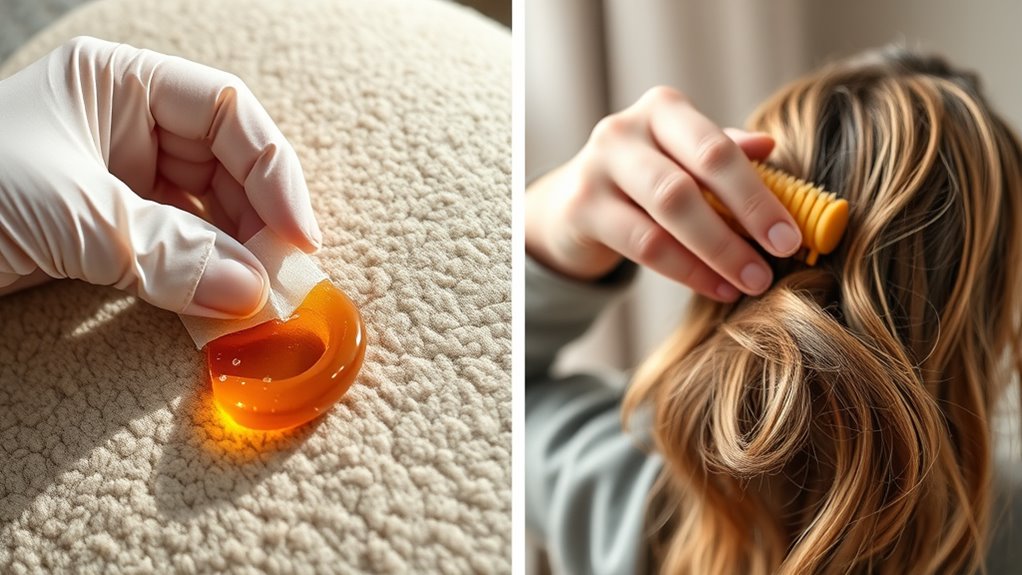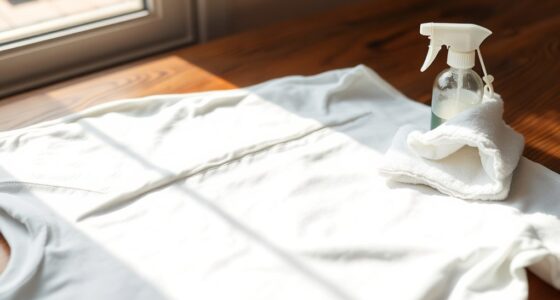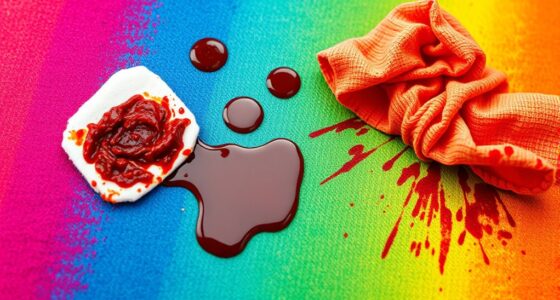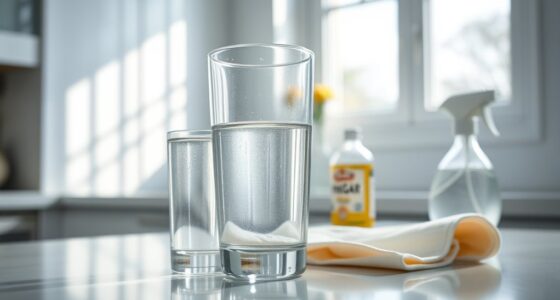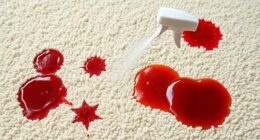To remove gum from upholstery and hair safely, start by hardening it with ice or a cold compress. For upholstery, gently scrape with a plastic spoon and treat stains with mild soap, vinegar, or rubbing alcohol if needed. For hair, apply oil like coconut or peanut butter to loosen the gum, then carefully work it out with your fingers or a fine-tooth comb. Keep gentle techniques in mind—more tips lie just ahead.
Key Takeaways
- Harden the gum with ice or a cold compress before gently scraping it away from upholstery or hair.
- Use household oils like coconut or olive oil to loosen gum from hair, then carefully work it out with fingers or a comb.
- Apply a mixture of mild dish soap and cold water to upholstery stains, blotting repeatedly until the gum lifts.
- Avoid metal tools and harsh chemicals; opt for gentle methods and test solutions on hidden fabric areas first.
- Remove gum promptly to prevent it from setting, ensuring safe, damage-free cleaning for both upholstery and hair.

Getting gum stuck in upholstery or hair can be frustrating, but fortunately, there are effective ways to remove it without causing damage. Whether it’s your favorite sofa or your child’s hair, knowing the right techniques for chewing gum removal can save you time and stress. The key is to act quickly and use household items or simple methods that won’t harm the fabric or strands. When tackling chewing gum removal, patience and care are essential to prevent further messes or damage.
If the gum is on upholstery, start by applying a cold compress or ice cube directly onto the sticky area. The cold hardens the gum, making it easier to lift without pulling or tearing the fabric. Once the gum becomes firm, gently scrape it off with a plastic spoon or a dull knife. Avoid metal tools that could scratch or damage your furniture. After removing the majority of the gum, you can treat the stain with household stain removal techniques. Lightly dab the area with a mixture of mild dish soap and cold water, then blot with a clean cloth. Repeat as needed until the stain lifts. For stubborn spots, a small amount of vinegar or rubbing alcohol applied with a soft cloth can help dissolve any remaining residue. Always test these solutions on a hidden part of the fabric first to confirm they won’t cause discoloration.
When gum sticks to hair, your approach is slightly different. First, don’t try to yank or pull the gum out directly, as that can cause hair breakage. Instead, apply ice cubes wrapped in a plastic bag or a cold compress to the gum for a few minutes. Once the gum hardens, gently work it away from the hair by applying a small amount of oil—such as coconut, olive, or even peanut butter. These household items help loosen the gum’s grip on the hair strands. Use your fingers or a fine-tooth comb to carefully work the gum out, starting from the ends and working toward the scalp. If you’re dealing with a large amount of gum, patience is key; take your time to prevent hair damage. After removal, wash the hair thoroughly with shampoo to remove any residual oil or sticky residue.
Additionally, understanding proper techniques can significantly improve your success in gum removal without damage. In both cases, avoiding harsh chemicals and aggressive scrubbing is vital. With the right techniques—like using household stain removal methods and gentle physical removal—you can successfully eliminate gum from upholstery and hair while keeping everything intact and undamaged. Acting promptly and choosing gentle, household solutions will make the process smoother and safer.
Frequently Asked Questions
Can I Use Hot Water to Remove Gum Safely?
Yes, you can use the hot water method to remove gum safely. It works by softening the gum, making it easier to peel off. Be sure to contemplate safety by testing the water temperature first to avoid burns, especially on delicate upholstery or hair. Use hot water carefully, and combine it with other gentle techniques like using a cloth or ice to prevent damage and ensure safe removal.
Is It Safe to Use Household Chemicals on Upholstery?
Think of household chemicals as a double-edged sword—you need to wield them carefully. It’s not always safe to use chemicals on upholstery without knowing their ingredients, as they can cause fabric damage. Always check for proper household chemical safety guidelines before applying, and test a small hidden area first. This prevents upholstery damage, keeps your furniture looking fresh, and makes sure you don’t accidentally harm yourself or your belongings.
How Long Should I Wait Before Attempting to Remove Gum?
You should wait until the gum hardens completely before attempting to remove it. This waiting period allows the gum to become firm, making it easier to lift off without spreading or smudging. Generally, give the gum about 15-30 minutes to solidify, depending on the temperature. Proper timing considerations are vital to avoid damaging your upholstery or hair, so be patient and guarantee the gum is fully hardened before starting removal.
Can Removing Gum Damage Delicate Fabrics or Hair?
Think of removing gum as delicate dance; it can harm fragile fabrics or cause hair damage if not done carefully. Using gentle methods preserves fabric safety and avoids pulling or tearing. If you’re cautious, you won’t risk damaging your upholstery or hair. Instead, you’ll glide through the process smoothly, ensuring your delicate items stay intact and your hair remains unharmed. Patience and gentle techniques are your best allies here.
Are There Any Home Remedies That Could Worsen the Stain?
Yes, some DIY solutions can worsen the stain or cause damage. For example, using harsh chemicals like acetone or nail polish remover might seem effective, but they pose chemical risks that could harm delicate fabrics or hair. Always test a small area first and opt for gentler methods like ice or natural oils. Avoid untested DIY solutions to prevent worsening the stain or damaging your upholstery or hair.
Conclusion
Now that you know how to remove gum safely from upholstery and hair, you’re armed with a trusty toolkit to tackle sticky situations. Think of it as freeing your belongings from an unwanted cling, like a bird shedding a stubborn feather. With patience and the right techniques, you’ll turn a sticky mess into a distant memory. So go ahead, confidently conquer gum mishaps—your quick thinking keeps things smooth and snag-free.
